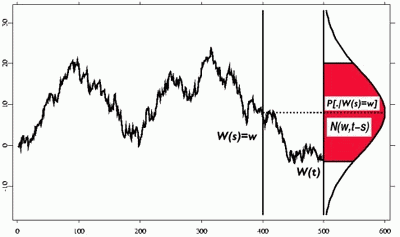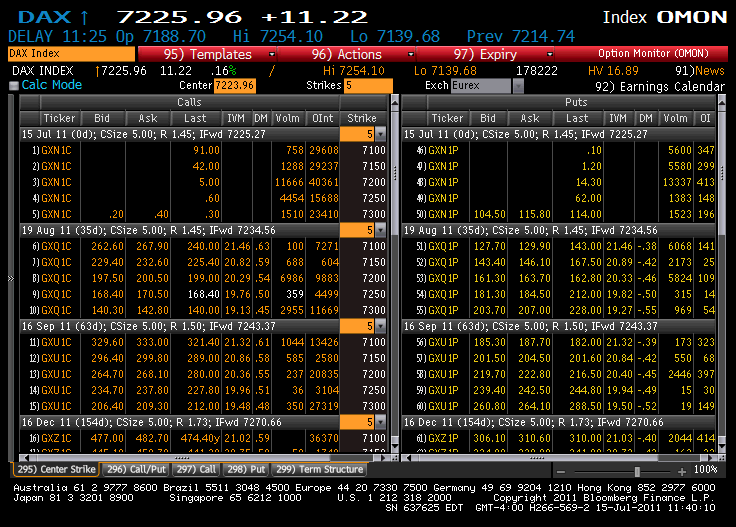Statistics of Financial Markets I (VL+UE)
![]()
![]()
- Kategorie
- Master (PhD level)
- Lehrende(r)
- W. Härdle, B. Choros-Tomczyk, W. Wang
Description
The course starts with an introduction into the basic concepts of option pricing and its probabilistic foundations. Next, stochastic processes in discrete time are presented and the Wiener process is introduced. Itô's Lemma is derived and the Black-Scholes (BS) Option model is presented leading to the analytic solution for the BS Option price. Numerical solutions via a binomial or trinomial tree constructions are discussed in detail.Contents
The course MVA I is required. Wiener processes, option based portfolio insurance, implied volatility dynamics, interest rate modelling, exotic options, binomial trees, option pricing, Black Scholes model. Visit of Frankfurt or Leipzig exchange.Course outline

 Learn from Nobel price winners, such as Engle (ARCH Models, 2003), Scholes, Merton, (Derivative Valuation, 1997) or Modigliani (Financial Markets Analysis, 1985) to understand statistics of financial markets !
Learn from Nobel price winners, such as Engle (ARCH Models, 2003), Scholes, Merton, (Derivative Valuation, 1997) or Modigliani (Financial Markets Analysis, 1985) to understand statistics of financial markets !
Picture Gallery
The course Statistics of Financial Markets I starts with an introduction into the basic concepts of option pricing and its stochastic foundations. After a short revision of basic statistical concepts we present the Wiener process as the core element of a probabilistic financial market model. Itô's calculus allows us to reach the first milestone of the course - the Black-Scholes (BS) European Option Pricing formula. The BS model is simple but seminal - as argued by Black in 1992: "Yet that weakness (simplicity) is also its greatest strength. People like the model because they can easily understand its assumptions . . . and if you can see the holes in the assumptions you can use the model in more sophisticated ways." This is also the main message of this part of the course - students should understand the BS model, see its strength and understand the possibility of its generalizations. The portfolio insurance (hedging) issues, concept of implied volatility, and tree-based (binomial and trinomial trees) are discussed. In addition to the European style derivatives the valuation of the American and modern Exotic derivatives are discussed. This course is not limited to the description of the models and methods but focuses on the statistical analysis, presents the applications to real financial data. In addition, important issues e.g. calibration to market data and connected numerical and statistical pitfalls are presented.
In the second part (Statistics of Financial Markets II), the course focuses on quantitative methods in risk management such as Value at Risk (VaR) and backtesting. The implications of the current Basel II directive to the risk management of the financial institution are discussed. The students will be equipped with the knowledge of the standard time-series models ARMA, unit-root tests, ARCH and GARCH models that are essential for understanding the standard risk-management models e.g. Risk Metrics methodology. The advanced statistical methods based on the Copulae dependence concept, Extreme Values, Neural Networks as well nonparametric and adaptive methods are introduced and applied to the risk management problems.
The class is addressed to students with excellent knowledge of multivariate statistics and students with good skills in statistical software. This course is a starting point for students interested in quantitative finance and students with ambitions to work in the derivative, investment and risk-control departments. Former students of this course work for example at Deutsche Bank, Sal. Oppenheim, Citigroup, European Central Bank, BAFin, KPMG, Nadler Company and many international universities.
Literature
- Franke, J., Härdle, W., and Hafner, C. (2011) Statistics of Financial Markets: an Introduction. 3rd ed., Springer Verlag, Heidelberg. ISBN: 978-3-642-16520-7 (599 p)
- Härdle, W., Hautsch, N. and Overbeck, L. (2009) Applied Quantitative Finance. 2nd extended ed., Springer Verlag, Heidelberg. ISBN 978-3-540-69177-8 (448 p)
- Hull (2005) Options, Futures, and Other Derivatives. 6th ed., Prentice Hall. ISBN 0-13-149908-4 (816 p)
- Härdle, W., Simar, L. (2007) Applied Multivariate Statistical Analysis. 2nd extended ed., Springer Verlag, Heidelberg. ISBN 3-540-72243-4 (456 p)
- Cizek, P., Härdle, W., Weron, R. (2011) Statistical Tools for Finance and Insurance. 2nd ed., Springer Verlag, Heidelberg. ISBN: 978-3-642-18061-3 (420 p)
